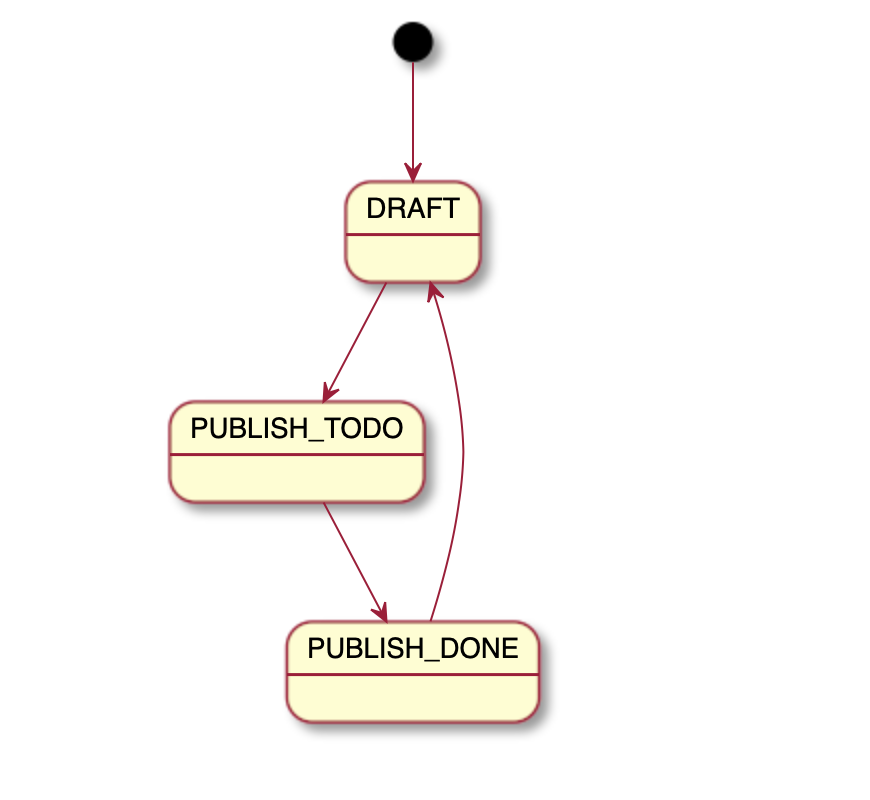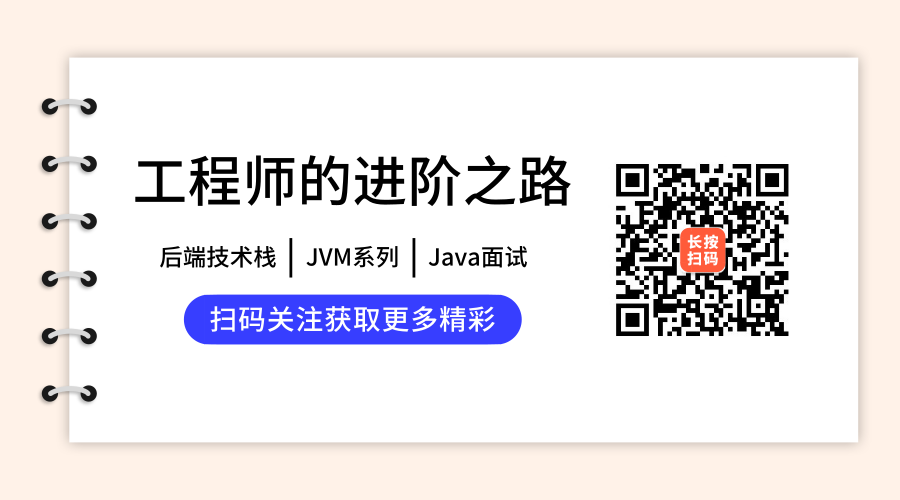Spring Boot 2.x实战之StateMachine
本文首发于个人网站:Spring Boot 2.x实战之StateMachine
Spring StateMachine是一个状态机框架,在Spring框架项目中,开发者可以通过简单的配置就能获得一个业务状态机,而不需要自己去管理状态机的定义、初始化等过程。今天这篇文章,我们通过一个案例学习下Spring StateMachine框架的用法。
案例介绍
假设在一个业务系统中,有这样一个对象,它有三个状态:草稿、待发布、发布完成,针对这三个状态的业务动作也比较简单,分别是:上线、发布、回滚。该业务状态机如下图所示。

实战
接下来,基于上面的业务状态机进行Spring StateMachine的演示。
- 创建一个基础的Spring Boot工程,在主pom文件中加入Spring StateMachine的依赖:
<?xml version="1.0" encoding="UTF-8"?>
<project xmlns="http://maven.apache.org/POM/4.0.0" xmlns:xsi="http://www.w3.org/2001/XMLSchema-instance"
xsi:schemaLocation="http://maven.apache.org/POM/4.0.0 https://maven.apache.org/xsd/maven-4.0.0.xsd">
<modelVersion>4.0.0</modelVersion>
<parent>
<groupId>org.springframework.boot</groupId>
<artifactId>spring-boot-starter-parent</artifactId>
<version>2.2.1.RELEASE</version>
<relativePath/> <!-- lookup parent from repository -->
</parent>
<groupId>online.javaadu</groupId>
<artifactId>statemachinedemo</artifactId>
<version>0.0.1-SNAPSHOT</version>
<name>statemachinedemo</name>
<description>Demo project for Spring Boot</description>
<properties>
<java.version>1.8</java.version>
</properties>
<dependencies>
<dependency>
<groupId>org.springframework.boot</groupId>
<artifactId>spring-boot-starter</artifactId>
</dependency>
<dependency>
<groupId>org.projectlombok</groupId>
<artifactId>lombok</artifactId>
<optional>true</optional>
</dependency>
<dependency>
<groupId>org.springframework.boot</groupId>
<artifactId>spring-boot-starter-test</artifactId>
<scope>test</scope>
<exclusions>
<exclusion>
<groupId>org.junit.vintage</groupId>
<artifactId>junit-vintage-engine</artifactId>
</exclusion>
</exclusions>
</dependency>
<!--加入spring statemachine的依赖-->
<dependency>
<groupId>org.springframework.statemachine</groupId>
<artifactId>spring-statemachine-core</artifactId>
<version>2.1.3.RELEASE</version>
</dependency>
</dependencies>
<build>
<plugins>
<plugin>
<groupId>org.springframework.boot</groupId>
<artifactId>spring-boot-maven-plugin</artifactId>
</plugin>
</plugins>
</build>
</project>
定义状态枚举和事件枚举,代码如下:
/**
* 状态枚举
**/
public enum States {
DRAFT,
PUBLISH_TODO,
PUBLISH_DONE,
}
/**
* 事件枚举
**/
public enum Events {
ONLINE,
PUBLISH,
ROLLBACK
}
- 完成状态机的配置,包括:(1)状态机的初始状态和所有状态;(2)状态之间的转移规则
@Configuration
@EnableStateMachine
public class StateMachineConfig extends EnumStateMachineConfigurerAdapter<States, Events> {
@Override
public void configure(StateMachineStateConfigurer<States, Events> states) throws Exception {
states.withStates().initial(States.DRAFT).states(EnumSet.allOf(States.class));
}
@Override
public void configure(StateMachineTransitionConfigurer<States, Events> transitions) throws Exception {
transitions.withExternal()
.source(States.DRAFT).target(States.PUBLISH_TODO)
.event(Events.ONLINE)
.and()
.withExternal()
.source(States.PUBLISH_TODO).target(States.PUBLISH_DONE)
.event(Events.PUBLISH)
.and()
.withExternal()
.source(States.PUBLISH_DONE).target(States.DRAFT)
.event(Events.ROLLBACK);
}
}
- 定义一个测试业务对象,状态机的状态转移都会反映到该业务对象的状态变更上
@WithStateMachine
@Data
@Slf4j
public class BizBean {
/**
* @see States
*/
private String status = States.DRAFT.name();
@OnTransition(target = "PUBLISH_TODO")
public void online() {
log.info("操作上线,待发布. target status:{}", States.PUBLISH_TODO.name());
setStatus(States.PUBLISH_TODO.name());
}
@OnTransition(target = "PUBLISH_DONE")
public void publish() {
log.info("操作发布,发布完成. target status:{}", States.PUBLISH_DONE.name());
setStatus(States.PUBLISH_DONE.name());
}
@OnTransition(target = "DRAFT")
public void rollback() {
log.info("操作回滚,回到草稿状态. target status:{}", States.DRAFT.name());
setStatus(States.DRAFT.name());
}
}
- 编写测试用例,这里我们使用CommandLineRunner接口代替,定义了一个StartupRunner,在该类的run方法中启动状态机、发送不同的事件,通过日志验证状态机的流转过程。
public class StartupRunner implements CommandLineRunner {
@Resource
StateMachine<States, Events> stateMachine;
@Override
public void run(String... args) throws Exception {
stateMachine.start();
stateMachine.sendEvent(Events.ONLINE);
stateMachine.sendEvent(Events.PUBLISH);
stateMachine.sendEvent(Events.ROLLBACK);
}
}
在运行上述程序后,我们可以在控制台中获得如下输出,我们执行了三个操作:上线、发布、回滚,在下图中也确实看到了对应的日志。不过我还发现有一个意料之外的地方——在启动状态机的时候,还打印出了一个日志——“操作回滚,回到草稿状态. target status:DRAFT”,这里应该是状态机设置初始状态的时候触发的。

分析
如上面的实战过程所示,使用Spring StateMachine的步骤如下:
- 定义状态枚举和事件枚举
- 定义状态机的初始状态和所有状态
- 定义状态之间的转移规则
- 在业务对象中使用状态机,编写响应状态变化的监听器方法
为了将状态变更的操作都统一管理起来,我们会考虑在项目中引入状态机,这样其他的业务模块就和状态转移模块隔离开来了,其他业务模块也不会纠结于当前的状态是什么,应该做什么操作。在应用状态机实现业务需求时,关键是业务状态的分析,只要状态机设计得没问题,具体的实现可以选择用Spring StateMachine,也可以自己去实现一个状态机。
使用Spring StateMachine的好处在于自己无需关心状态机的实现细节,只需要关心业务有什么状态、它们之间的转移规则是什么、每个状态转移后真正要进行的业务操作。
本文完整实例参见:https://github.com/duqicauc/Spring-Boot-2.x-In-Action/tree/master/statemachinedemo
参考资料
- http://blog.didispace.com/spring-statemachine/
- https://projects.spring.io/spring-statemachine/#quick-start
本号专注于后端技术、JVM问题排查和优化、Java面试题、个人成长和自我管理等主题,为读者提供一线开发者的工作和成长经验,期待你能在这里有所收获。





 浙公网安备 33010602011771号
浙公网安备 33010602011771号